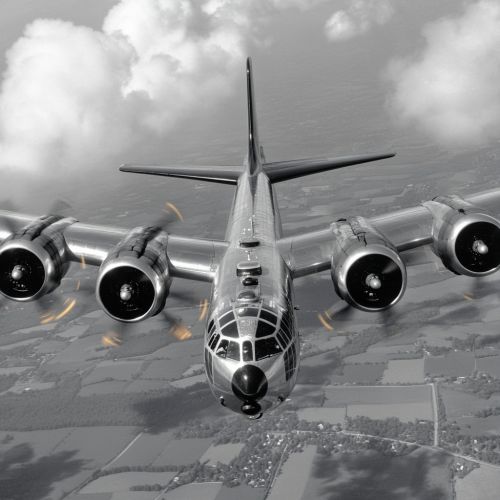Boeing B-29 Superfortress: Difference between revisions
(Created page with "== Introduction == The Boeing B-29 Superfortress was a four-engine propeller-driven heavy bomber designed by Boeing and used by the United States during World War II and the Korean War. Renowned for its advanced technology and significant role in the Pacific Theater, the B-29 was one of the largest aircraft operational during World War II and was notable for its pressurized cabin, dual-wheeled tricycle landing gear, and an electronic fire-control system. <div class='on...") |
No edit summary |
||
| Line 3: | Line 3: | ||
The Boeing B-29 Superfortress was a four-engine propeller-driven heavy bomber designed by Boeing and used by the United States during World War II and the Korean War. Renowned for its advanced technology and significant role in the Pacific Theater, the B-29 was one of the largest aircraft operational during World War II and was notable for its pressurized cabin, dual-wheeled tricycle landing gear, and an electronic fire-control system. | The Boeing B-29 Superfortress was a four-engine propeller-driven heavy bomber designed by Boeing and used by the United States during World War II and the Korean War. Renowned for its advanced technology and significant role in the Pacific Theater, the B-29 was one of the largest aircraft operational during World War II and was notable for its pressurized cabin, dual-wheeled tricycle landing gear, and an electronic fire-control system. | ||
[[Image:Detail-99429.jpg|thumb|center|A Boeing B-29 Superfortress in flight, showcasing its four-engine configuration and sleek design.]] | |||
== Development and Design == | == Development and Design == | ||
Revision as of 00:59, 30 October 2024
Introduction
The Boeing B-29 Superfortress was a four-engine propeller-driven heavy bomber designed by Boeing and used by the United States during World War II and the Korean War. Renowned for its advanced technology and significant role in the Pacific Theater, the B-29 was one of the largest aircraft operational during World War II and was notable for its pressurized cabin, dual-wheeled tricycle landing gear, and an electronic fire-control system.

Development and Design
The development of the B-29 Superfortress began in the late 1930s, driven by the United States Army Air Corps' need for a long-range bomber capable of delivering substantial payloads over vast distances. The project, initially designated as the Model 345, was awarded to Boeing in 1940. The design incorporated cutting-edge technologies, including a pressurized cabin, which allowed crews to operate at high altitudes without oxygen masks, and a remote-controlled gun turret system, which was revolutionary at the time.
The B-29's design featured a high-aspect-ratio wing, which improved aerodynamic efficiency and fuel economy. The aircraft was powered by four Wright R-3350 Duplex-Cyclone radial engines, each capable of producing 2,200 horsepower. These engines were equipped with turbo-superchargers, enabling the B-29 to reach altitudes of up to 31,850 feet, thus avoiding enemy fighters and anti-aircraft fire.
Operational History
The B-29 Superfortress first saw combat in 1944, with its initial missions targeting Japanese industrial facilities. The aircraft's long range allowed it to conduct bombing raids from bases in China and later from the Mariana Islands, following the capture of Saipan, Tinian, and Guam. The B-29 was instrumental in the strategic bombing campaign against Japan, culminating in the atomic bombings of Hiroshima and Nagasaki in August 1945.
During the Korean War, the B-29 was employed in both strategic and tactical roles, including interdiction missions against North Korean supply lines and infrastructure. Despite being increasingly vulnerable to Soviet-built MiG-15 jet fighters, the B-29 continued to serve effectively due to its payload capacity and range.
Technological Innovations
The B-29 was a marvel of engineering, incorporating several technological innovations that set it apart from its contemporaries. The pressurized cabin was a significant advancement, allowing the crew to operate comfortably at high altitudes. The aircraft's electronic fire-control system, developed by General Electric, enabled gunners to operate remote-controlled turrets with remarkable accuracy. This system used analog computers to calculate firing solutions, a precursor to modern digital fire-control systems.
The B-29 also featured an advanced bombing system, the Norden bombsight, which provided unprecedented accuracy in targeting. This technology was complemented by the aircraft's ability to carry a variety of ordnance, including conventional bombs, incendiaries, and eventually, nuclear weapons.
Variants and Modifications
Several variants of the B-29 were developed to fulfill different roles and improve performance. The B-29A featured a stronger wing structure and improved defensive armament. The B-29B was a stripped-down version, optimized for low-altitude bombing with reduced defensive armament to increase speed and range.
Post-war, the B-29 was adapted for various roles, including reconnaissance (RB-29), in-flight refueling (KB-29), and weather reconnaissance (WB-29). These modifications extended the aircraft's service life and utility in peacetime operations.
Legacy and Impact
The B-29 Superfortress had a profound impact on aerial warfare, setting new standards for range, payload, and technological sophistication. Its role in ending World War II and its continued service during the Korean War underscored its strategic importance. The B-29's design and technological innovations influenced subsequent bomber designs, including the Boeing B-50 Superfortress and the Boeing B-47 Stratojet.
The B-29 also played a pivotal role in the development of the United States' nuclear capabilities, being the first aircraft to deliver atomic bombs in combat. This aspect of its history has been the subject of extensive study and analysis, highlighting the ethical and strategic implications of nuclear warfare.
Preservation and Cultural Significance
Today, several B-29 aircraft are preserved in museums and airshows, serving as a testament to their historical significance. Notable examples include "Enola Gay" and "Bockscar," the aircraft that dropped atomic bombs on Hiroshima and Nagasaki, respectively. These aircraft are displayed at the National Air and Space Museum and the National Museum of the United States Air Force, where they continue to educate the public about their role in history.
The B-29 has also been featured in various films, documentaries, and literature, reflecting its enduring legacy in popular culture. Its technological advancements and historical impact continue to be subjects of interest for aviation enthusiasts and historians alike.
